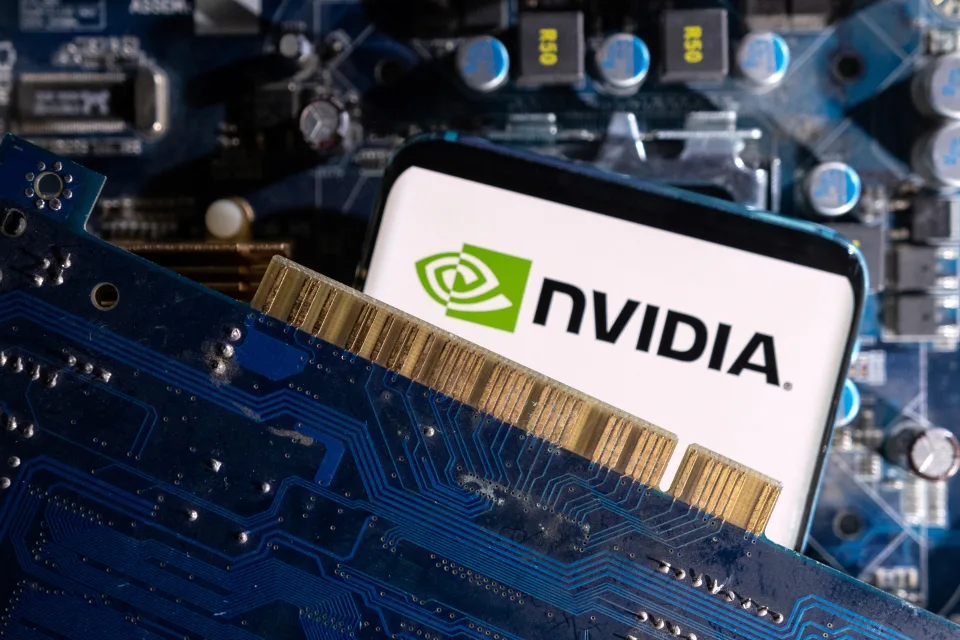You may not have heard about Nvidia, but thanks to the artificial intelligence boom it’s now one of the most valuable companies in history.
The company has for years made the computer chips that can run graphics-heavy video games. But several years ago, artificial intelligence researchers began using those same chips to run the powerful new algorithms that were causing breakthroughs in the field.
This week the company reported earnings and explained the incredible surge in demand it has seen as the tech world races to create new versions of AI – prompting potentially the largest one-day increase in a company’s value, ever.
The 24 percent rise in stock price means Nvidia is now worth $939.3 billion. That’s more than Tesla and Facebook, which are worth $584.7 billion and $647.6 billion, respectively. And it sits just behind the Big Tech companies of Apple, Google, Microsoft and Amazon and Saudi state oil giant Saudi Aramco – the only companies more valuable.
Nvidia began in 1993 as the brainchild of three computer chip engineers, who predicted that as computers developed, they would need to get better at processing complex visuals. The bet paid off, and by the early 2000s, the company had won a contract to make chips for Microsoft’s Xbox gaming console. Since then, Nvidia has continued to grow as the video game market has exploded and eclipsed the film, television and music industries in sheer size and value.
But the current boom has come as Big Tech companies and start-ups alike scramble to buy the company’s graphics processing units, or GPU chips, for a totally different reason. The chips are well-suited to crunching the massive amounts of data that are necessary to train cutting-edge artificial intelligence programs like Google’s PaLM 2 or OpenAI’s GPT4. Nvidia has been steadily growing its AI-focused business over the past several years, but the explosion of interest and investment in the space over the past six months has turbocharged its sales.
Training AI models demands chips that have high amounts of memory, said Greg Osuri, the founder of Akash Networks, a marketplace for companies to sell access to their GPUs to other firms that need it. “Nvidia happens to be the only company that makes those chips.”
For months, start-ups trying to get into the AI race have competed with Big Tech companies for Nvidia’s GPUs. At the Newcomer AI conference in March, David Luan, co-founder of AI start-up Adept Labs and a former Google and OpenAI engineer, said once an AI company figures out its business model, they need venture capital money so they can begin “sending checks to Jensen,” referring to Jensen Huang, Nvidia’s CEO.
A set of eight of the most advanced chips can cost $300,000, Osuri said. Companies buy thousands of them. Twitter owner Elon Musk recently bought about 10,000 GPUs as part of his plans to start a new AI company of his own, according to a report in Insider.
The launch of OpenAI’s ChatGPT, a chatbot that could have complex conversations, pass professional licensing exams and write computer code, in November helped show the promise of the technology, essentially serving as a firing pistol for a new AI arms race.
In a conference call with investors on Wednesday, Nvidia’s Chief Financial Officer Colette Kress called ChatGPT’s launch the technology’s “iPhone moment,” marking the point at which the world realized the potential for the new tech.
“The technology came together and helped everybody realize what an amazing product it can be and what capabilities it can have,” Kress said.
Nvidia’s stock had already more than doubled this year as the AI boom took off, but the company blew past already-high expectations on Wednesday when it forecast that sales in the second quarter would be $11 billion, compared with the $7 billion that Wall Street analysts had forecast.
The numbers “blew everyone away,” said CJ Muse, an analyst with Evercore Inc. “No one saw that.”
The dependency on Nvidia is so widespread that Big Tech companies have been working on developing their own competing chips, much in the same way as Apple spent years developing its own chips so it could avoid having to rely on – and pay – other companies to outfit its devices. Google has built its own “Tensor Processing Units” for several years, and both Microsoft and Amazon have programs to design their own as well.
Even so, those alternatives won’t be enough for the biggest companies, Muse said. “I think Nvidia dominance will continue.”

